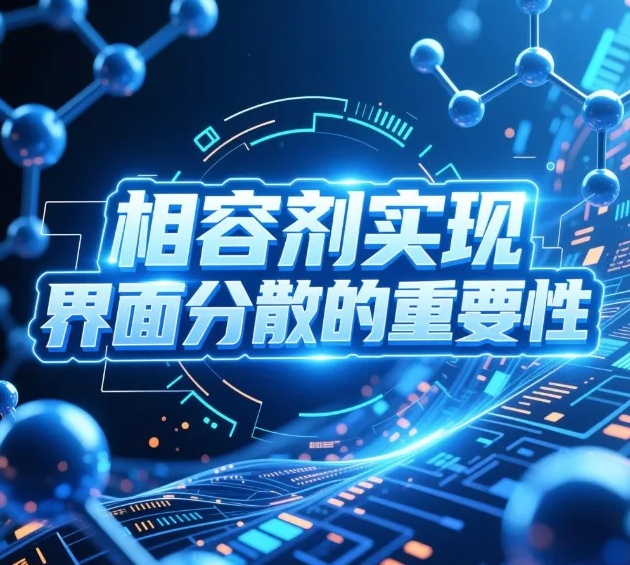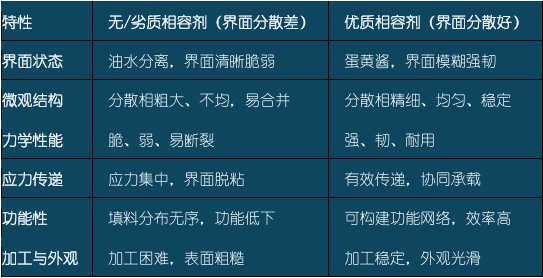How important is the achieving of "interface dispersion" by compatibilizers?

The realization of "interfacial dispersion" by compatibilizers is not just important but crucial; it is the core and soul of the entire compatibilizer technology.
You can understand this "interface dispersion" process asThe key step in changing incompatible polymers from an "oil-water separation" state to a "mayonnaise" state.Below, I will explain its importance in detail from several perspectives.
1. What is "interface dispersion"?
It consists of two closely connected and complementary processes:
1. Interface CompatibilityCompatibilizer molecules act like "double-sided tape" or "bridges," with one end compatible with polymer A and the other end compatible with polymer B. They spontaneously accumulate at the interface of the two-phase polymers and, through intermolecular forces (such as chain entanglement, hydrogen bonding, ionic bonding, chemical reactions, etc.),Significantly reduce the interfacial tension between the two phases.。
2. Dispersion and RefinementWhen the interfacial tension is reduced, the external forces (such as shear force and tensile force) during blending can more easily break and stretch the dispersed phase (usually the minor component), forming smaller and more uniform microdomains.Prevent them from re-aggregating stably.。
In simple terms: interface compatibility is about "creating conditions," while dispersion and refinement are about "achieving results." Without good interface compatibility, stable and fine dispersion cannot be achieved.
"2. Why is 'interface dispersion' so important?"
Its importance is directly reflected in the "life or death" of the final material performance.
1. The Foundation of Mechanical Properties: From "Fragile Interface" to "Strong Link"
Poor interface distractionThe two-phase interface is clear and smooth, lacking effective adhesion. When the material is subjected to external forces, stress will concentrate on the weak interface, quickly leading to...Interface debonding (phase separation)Microcracks form and eventually develop into macroscopic failure. The material will exhibitLow intensity, low toughness, brittle.。
Good interface distributionThe compatibilizer forms a strong "transition layer" at the interface. When the material is subjected to force, the stress can be effectively transferred from one phase to another through this tough interface.Cooperative BearingThis usually means:
👉Significant improvement in impact strength/toughnessCrack propagation requires more energy consumption.
👉Increase in tensile strength and flexural strengthThe integrity of the material is better.
👉Increased elongation at breakMaterials can undergo greater deformation before fracturing.
Just like the relationship between cement and sand. Without cement (compatibilizer), sand (dispersed phase) and gravel (continuous phase) are just a loose pile, easily crushed. With cement, they can bind together to form solid concrete.
2. The Guarantee of Stable Morphological Structure: From "Rough Large Reefs" to "Refined Islands"
Poor interface distractionThe dispersed phase particles are coarse (up to micron level or even larger), uneven in size, and prone to aggregation and coalescence during processing or use. This coarse phase structure is the root cause of performance degradation.
Good interface distributionFormationFine, uniform, and stable "island structure"The dispersed phase size can be refined to submicron or even nanometer levels. This fine morphology not only benefits mechanical properties but also greatly increases the contact area between the two phases, providing more pathways for stress transfer.
3. The premise of functionality realization: setting the stage for the oriented distribution of functional fillers.
In many functional composite materials, it is necessary to selectively distribute functional fillers (such as conductive carbon black, thermally conductive boron nitride, flame retardants, etc.) in a specific phase or at the interface.
Good interface dispersionCreated a clear, stable, and large interface area that can serve as a "habitat" for functional fillers to achieve."Double continuum" or "isolated structure"This is crucial for the preparation of highly conductive and thermally conductive materials. If the interface is rough and unstable, the distribution of fillers will be uncontrolled, making it impossible to form an effective functional network.
4. Improvement of workability and appearance
Poor interface distractionPoor melt strength can lead to phenomena such as melt fracture and extrudate swell, making processing difficult. The surface of the product often shows defects such as roughness, fiber float, and fisheyes.
Good interface distributionThe melt flow is more uniform, the processing window is wider, and the surface of the product is smoother and more delicate.
3. Summary and Metaphor

The ultimate goal of using compatibilizers to achieve "interface dispersion" is to "assemble" multiple macroscopically incompatible components into a completely new composite material at the microscopic scale, which is stable, reliable, and has superior performance compared to the simple addition of each component.It determines whether the blend material is "waste" or "treasure." Therefore, in polymer blend modification, selecting and designing a suitable compatibilizer and ensuring effective "interface dispersion" is the most critical aspect of a successful formulation, bar none.
【Copyright and Disclaimer】The above information is collected and organized by PlastMatch. The copyright belongs to the original author. This article is reprinted for the purpose of providing more information, and it does not imply that PlastMatch endorses the views expressed in the article or guarantees its accuracy. If there are any errors in the source attribution or if your legitimate rights have been infringed, please contact us, and we will promptly correct or remove the content. If other media, websites, or individuals use the aforementioned content, they must clearly indicate the original source and origin of the work and assume legal responsibility on their own.
Most Popular
-

BASF Signs Another Giant: Covestro Already Set Up, Just Missing Wanhua Chemical?
-

Clariant Unveils Cost-Cutting Plan Details, Plans to Shut Down Multiple Plants
-

Clariant Plans to Shut Down Multiple Plants! Wingtech Releases Latest Statement! Oriental Yuhong Acquires Stake in Brazilian Company
-

U.S. Appeals Court Officially Rules: Trump Tariff Unlawful and Void!
-

ExxonMobil Plans to Close UK Ethylene Plant; GPI's Revenue & Profit Both Decline! Haitian's Serbia Base Enters Mass Production






